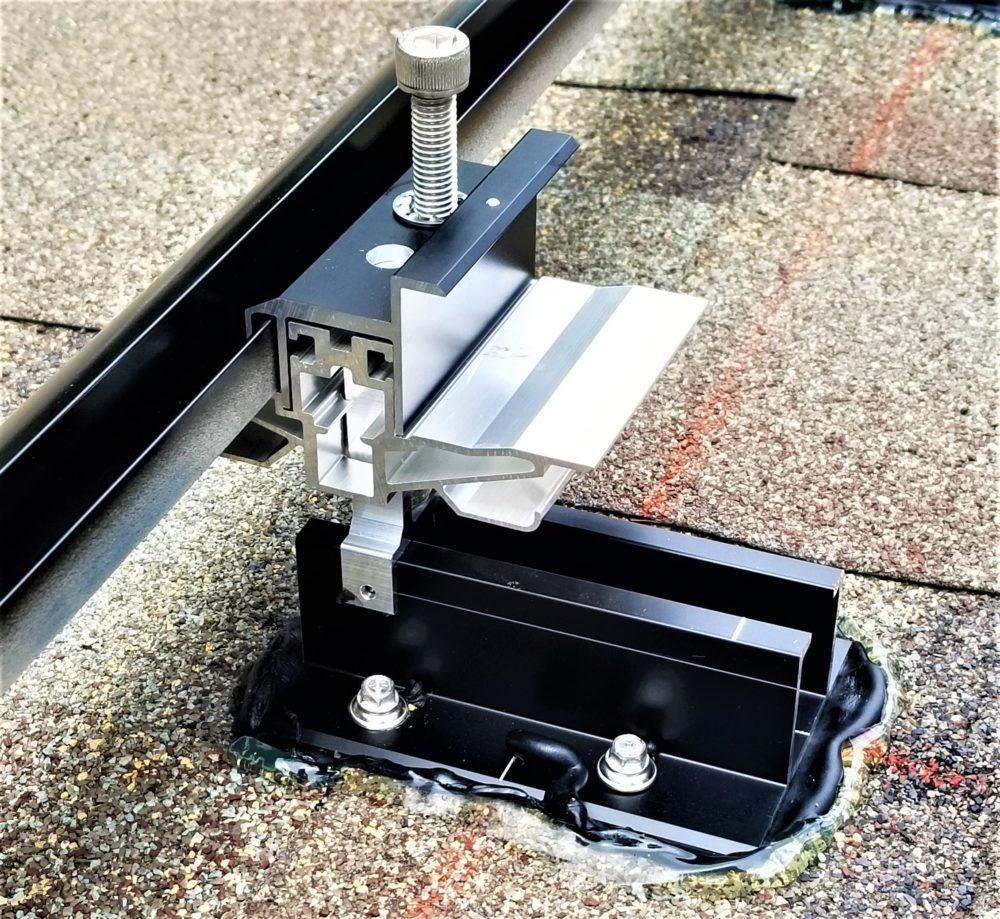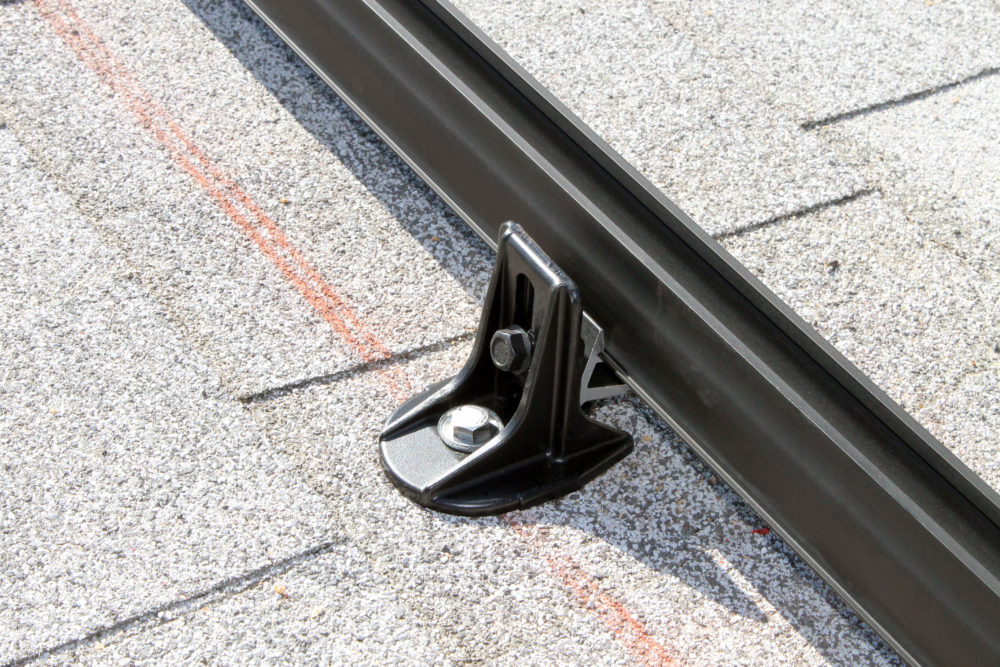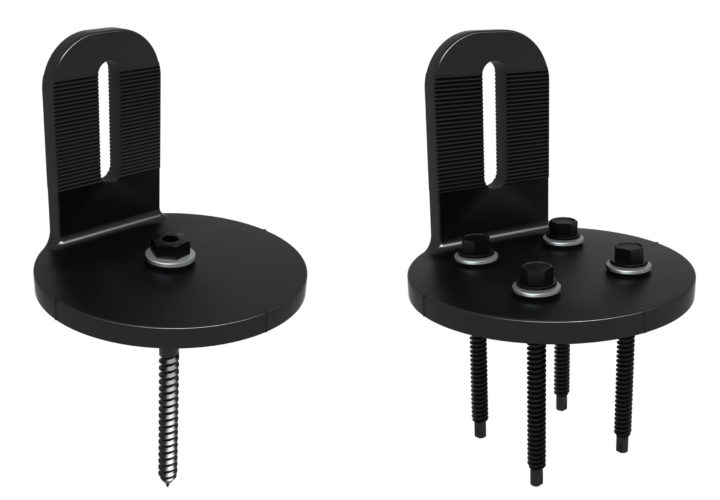Aluminum and other metallic solar flashing requires installers to pry composite shingles up to slide the sealing roof attachment beneath. Depending on the condition of the roof covering, shingles can break in the prying process, leaving installers responsible for sourcing and replacing them.
Back in 2012, solar roof mount manufacturer QuickBOLT (SolarRoofHook at the time) released a lag bolt-driven roof attachment by the same name with a rubber puck accessory dubbed Microflashing. The QuickBOLT product didn’t require a mechanical flashing — instead, it went straight through the shingle into the rafter. It uses roof sealant, Microflashing and the force from the driven lag to create a waterproof seal.
At the same time, EJOT carried a lag bolt mount with a smaller washer, and Zep Solar offered an over-the-shingle mount that was acquired by SolarCity (and has been seen on recent Tesla installs). Jared Wiener, executive VP of QuickBOLT, said that it took until 2016 for Microflashing to catch on, and now the company has sold over 2 million units.
Since then, several other manufacturers have released similar mounting solutions with smaller overall footprints that are flashing-free, use a chemical flashing or have minimal flashing when compared to the typical aluminum under-shingle solution.
“That to me is fantastic. It’s a testament to the quality of the technology,” Wiener said.
Reduced-flashing products
Each of these over-the-shingle roof mount options have different individual components but require similar steps for installation. In most cases, it takes finding the rafter, drilling a pilot hole through the shingle, filling it with sealant and driving the lag bolt through. The shared attribute is no shingle-prying required.
The mounting manufacturers with over-the-shingle roof mounts consulted for this story and their relevant products are as follows:
- Unirac released FLASHLOC COMP in 2019, which is a two piece system — the mount and the lag bolt/washer. The installer fills a reservoir in the attachment with sealant after the lag bolt is driven until it expels from two vents, further sealing the penetration with a “chemical flashing.”
- Roof-Tech’s RT-MINI, RT-Apex and RT-AIR use a butyl tape on the roof-facing surface to “self-flash.” Each model is designed with four potential mounting points that can be used in both decking (four screws) and rafters (two screws). These mounts use stainless steel woodscrews as opposed to lag bolts.
- SunModo released a flashing-free over-the-shingle mount called NanoMount this spring that comes in both rafter and decking models. The rafter NanoMount requires one lag bolt, while the decking model uses up to four. The bottom of the attachment has a silicon gasket that self-seals as the lag passes through it, requiring no pilot holes.
- SnapNrack just brought its SpeedSeal Track and Foot to the market in October. SpeedSeal Foot is compatible with the company’s Ultra Rail Roof Mount series and the Track with the RL-U Roof Mount. SpeedSeal has an EPDM compressible ring that is filled with sealant through a pilot hole. When driven, it creates a seal.
- And QuickBOLT, whose Microflashing set the course. The company is soon releasing Deck Mount, a T-foot over-the-shingle mount with four lag screw points and a silicon adhesive bottom for comp shingle decking attachment.
Each product has run the gamut of waterproofing and wind and weatherization testing, but aluminum or mechanical flashing remains a common practice in solar roof mounts.
“In most places, it’s been accepted by AHJs, but there are still hang ups,” said Connor Morrison, product manager for Unirac, about minimal flashing products. “Naturally, that’s an old school way of thinking.”
Designed with installer in mind
These minimal roof mounts with smaller overall footprints match the necessary number of attachments to hold a rooftop solar array as those using mechanical flashing. And every component required to install them can often fit in one box, meaning fewer trips down the ladder for installers.
John Ferreira, training analyst in operations training for Sunrun, has been installing solar since 2012. He found that in colder conditions, the sealant used with mechanical flashing would often freeze. The company recently started working with SnapNrack’s SpeedSeal and other over-the-shingle mounts and found that sealant freezing wasn’t an issue given the speed to install.
The fewer materials in over-the-shingle roof mounts can also mean less investment for installers, and many come with 25-year warranties.
“I do believe it’s important to note that all we’re trying to do here is help the solar industry,” QuickBOLT’s Wiener said. “Our job is making solar more affordable, and I personally want to see the solar industry grow in the United States. In a way, that allows people to get over the biggest hurdle.”
Special installation considerations
When using these Microflashing-style mounts, installers should take extra care to find the rafter. One advantage of mechanical flashing is a larger surface area and more room for error with mis-drilled pilot holes.
Another concern is the materials used in certain products can be incompatible with composition shingles. EPDM rubber is chemically incompatible with asphalt, a major ingredient in comp shingle rooftops.
These products can come with a sealant solution included in the mounting kit, but in case they don’t, it’s recommended to look for one that can work on multiple substrates and climates; and that the sealant has a history of prior roofing applications.
Despite the few extra considerations, minimal-flashing options can help installers do their jobs quicker and lessen the possibility of damage to shingles during installation.
“I think that the mechanical- or flashing-less installations are the way of the future,” SunRun’s Ferreira said. “I would be upset if I was an installer and had to go back to mechanical flashing, that’s for sure.”








As a homeowner I don’t recommend them. My contractor used envision flashless mounts which leaked after 9 years on GAF composite roofing (which also turned out to be subpar and the thirty year shingles are done after twenty years. Three rafters are now water conduits to the wall.
I have to wonder about wind loads. What are the pull test results for these deck feet that are simply attached with lags directly into plywood? Also how will they last over the course of 25 years? It does not seem to be quality driven. It looks like something I did when building a tree fort when I was 10 years old. When I got into Solar over a decade ago smaller companies seemed to really take quality serious. Now that large corporations have taken over the industry the quality has dropped drastically. The main reason a large company is able to use a deck foot like “SpeedSeal” is lobbying to law makers. Don’t take my word for it, look at the Better Business Bureau of the larger companies. Some of the top contenders have a 2.5 rating or less. That is a risky prospect when you get young untrained kids installing this stuff on your roof. I recommend to any homeowner research your installer and the company they contract for with a fine tooth comb, before you sign that check. Look at their reputation locally not just online. I think companies that install roofs and do solar tend to be better as long as they have a good local reputation. Allot of online reviews are candy coated by large companies, in fact they have a department that specifically handles online reviews. They pay people to cover their horrible installs and ridiculous delays in getting Permission To Operate. How do I know? I worked for a couple of them. I saw it first hand. I couldn’t handle it and had to get out of the business. I may work for a smaller quality driven solar company in the future, but not a big one. Take my first hand advice: Steer clear of companies that brag about how BIG they are. The bigger they are, the more insignificant you are to them as a customer. Trust me you are ultimately a dollar sign to them, nothing more nothing less.
Here are some articles about material incompatibilities regarding EPDM and roofing products such as bituminous systems. Better to be safe than sorry.
https://www.professionalroofing.net/Articles/Chemical-considerations–11-01-2017/4127
https://www.linkedin.com/pulse/architectscontractors-should-understand-material-matthew/
“Back in 2012, solar roof mount manufacturer QuickBOLT (SolarRoofHook at the time) released a lag bolt-driven roof attachment by the same name with a rubber puck accessory dubbed Microflashing. The QuickBOLT product didn’t require a mechanical flashing — instead, it went straight through the shingle into the rafter. It uses roof sealant, Microflashing and the force from the driven lag to create a waterproof seal.”
My old solar PV system used the flashing and a copious amount of a sealant that was called “black jack”. For 15 years of ownership absolutely no leaks in the roof due to solar PV panel installation. With the sealants available today, I can see the wisdom of the QuickBOLT product, lower costs in time and components, less components in the system to fail and (IF) and when one has to remove the solar PV panels and redo the roof, easier to remove and replace.
One has to realize, with most of these solar PV systems you may well be looking at a product that will be on the roof for at least 25 to 35 years and in some cases it may be a legacy 50 year installation. The industry is changing almost every day. You have announcements where a new panel manufacturer comes along, can produce a quality product cheaper with a longer warranty for less. This is the claim of new entry Violet Power who believes it’s IBS technology panels can be cheaper, on the upper end of efficiency around 25% and have a (warranty) of (50) years in specification power production. This is a legacy product one can leave to their grandchildren. “The future’s so bright, I’ve gotta’ wear shades.”
This is not exactly correct: “Another concern is the materials used in certain products can be incompatible with composition shingles. EPDM rubber is chemically incompatible with asphalt, a major ingredient in comp shingle rooftops. ”
There has been no instance found where EPDM was incompatible with Asphalt Shingles. The study linked to the claim does not state EPDM is incompatible with Comp Shingles or even Asphalt Shingles if you prefer. The study claimed EPDM was incompatible with asphalt in relation to automobile tires (EPDM rubber) meeting asphalt (meaning driving on the road).